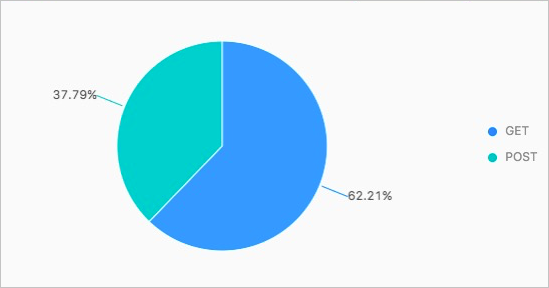本文介绍多目标Logstore数据分发的各种场景(动态分发、跨账号分发、跨账号动态分发、复杂场景动态分发等)及操作步骤。
背景信息
日志服务数据加工功能支持将加工结果分发到多个目标Logstore中。您可以在保存数据加工结果时,设置不同账号的AccessKey信息,将加工结果分发到不同账号的Logstore中;您也可以使用e_output函数、e_coutput函数动态获取目标Project和Logstore,将加工结果分发到不同的Logstore中。
最多跨20个账号分发加工结果。
如果您使用的是e_output函数,则通过e_output函数输出日志到指定的Logstore后,对应的日志不再执行后面的加工规则。如果您希望输出日志到指定的Logstore后,对应的日志还能继续执行后面的加工规则,可使用e_coutput函数。更多信息,请参见e_output、e_coutput。本文以e_output函数为例。
场景1:跨账号分发
例如:某网站所有的访问日志存储在一个Logstore中,现在希望将不同状态的日志分发存储到不同账号下的Logstore中。
针对上述需求,您可以通过日志服务数据加工功能解决。
原始日志
http_host: example.com http_status: 200 request_method: GET request_uri: /pic/icon.jpg scheme: https http_host: example.org http_status: 301 request_method: POST request_uri: /data/data.php scheme: http http_host: example.net http_status: 404 request_method: GET request_uri: /category/abc/product_id scheme: https http_host: aliyundoc.com http_status: 504 request_method: GET request_uri: /data/index.html scheme: https分发需求
http_status为2XX的日志存储到存储目标target0中的Logstore0中,并设置日志主题为success_event。
http_status为3XX的日志分发到存储目标target1中的Logstore1中,并设置日志主题为redirection_event。
http_status为4XX的日志分发到存储目标target2中的Logstore2中,并设置日志主题为unauthorized_event。
http_status为5XX的日志分发到存储目标target3中的Logstore3中,并设置日志主题为internal_server_error_event。
其中target0在账号A下,target1、target2和target3在账号B下。
加工规则
e_switch(e_match("status", r"2\d+"), e_set("__topic__", "success_event"), e_match("status", r"3\d+"), e_compose(e_set("__topic__", "redirection_event"), e_output("target1")), e_match("status", r"4\d+"), e_compose(e_set("__topic__", "unauthorized_event"), e_output("target2")), e_match("status", r"5\d+"), e_compose(e_set("__topic__", "internal_server_error_event`"), e_output("target3")) )存储目标
在创建数据加工任务面板中,配置存储目标。更多信息,请参见创建数据加工任务。
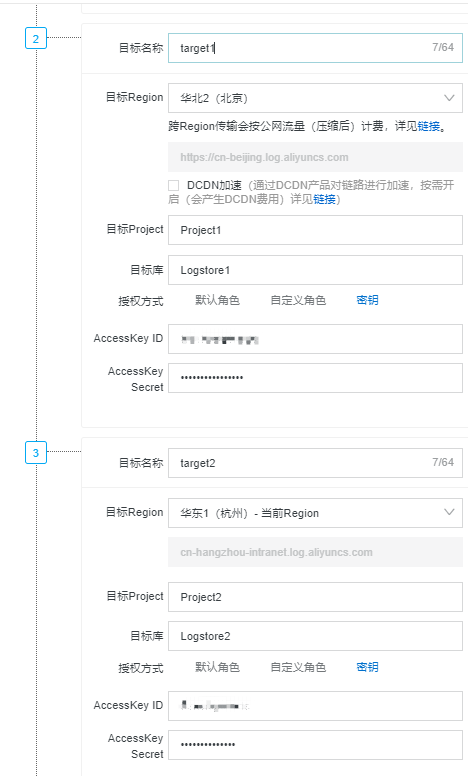
标号
存储目标
目标Project和Logstore
AccessKey
1
target0
Project0、Logstore0
账号A的AccessKey信息
2
target1
Project1、Logstore1
账号B的AccessKey信息
3
target2
Project2、Logstore2
账号B的AccessKey信息
4
target3
Project3、Logstore3
账号B的AccessKey信息
加工结果
## http_status为2XX的日志,分发到账号A下logstore0中。 __topic__: success_event http_host: example.com http_status: 200 request_method: GET request_uri: /pic/icon.jpg scheme: https ## http_status为3XX的日志,分发到账号B中的Logstore1中。 __topic__: redirection_event http_host: example.org http_status: 301 request_method: POST request_uri: /data/data.php scheme: http ##http_status为4XX的日志,分发到账号B中的Logstore2中。 __topic__: unauthorized_event http_host: example.net http_status: 404 request_method: GET request_uri: /category/abc/product_id scheme: https ## http_status为5XX的日志,分发到账号B中的Logstore3中。 __topic__: internal_server_error_event http_host: aliyundoc.com http_status: 504 request_method: GET request_uri: /data/index.html scheme: https
场景2:简单场景动态分发
例如:某网站所有的访问日志存储在一个Logstore中,现在希望根据project字段和logstore字段分发存储到不同的Logstore中。
针对上述需求,您可以通过日志服务数据加工功能解决。
原始日志
__tag__:type: dynamic_dispatch host: example.aliyundoc.com project: Project1 logstore: Logstore1 http_status: 200 request_method: GET request_uri: /pic/icon.jpg scheme: https __tag__:type: dynamic_dispatch host: demo.aliyundoc.com project: Project1 logstore: Logstore2 http_status: 301 request_method: POST request_uri: /data/data.php scheme: http __tag__:type: dynamic_dispatch host: learn.aliyundoc.com project: Project2 logstore: Logstore1 http_status: 404 request_method: GET request_uri: /category/abc/product_id scheme: https __tag__:type: dynamic_dispatch host: guide.aliyundoc.com project: Project2 logstore: Logstore2 http_status: 504 request_method: GET request_uri: /data/index.html scheme: https分发需求
根据日志中project字段和logstore字段的值的不同,进行动态分发。
为日志添加__tag:__type字段,值为dynamic_dispatch。
加工规则
e_output(project=v("project"), logstore=v("logstore"), tags={"type": "dynamic_dispatch"})e_output函数动态提取project字段和logstore字段的值进行日志分发。
存储目标
在创建数据加工任务页面中,设置默认存储目标即可,用于存储其他在加工过程中没有被丢弃的日志。
说明此场景中,动态分发的目标Project和Logstore由e_output函数中的配置决定,与创建数据加工任务页面中默认存储目标(标号1)中配置的目标Project和Logstore无关。

加工结果
## 分发到Project1下的Logstore1中。 __tag__:type: dynamic_dispatch host: example.aliyundoc.com project: Project1 logstore: Logstore1 http_status: 200 request_method: GET request_uri: /pic/icon.jpg scheme: https ## 分发到Project1下的Logstore2中。 __tag__:type: dynamic_dispatch host: demo.aliyundoc.com project: Project1 logstore: Logstore2 http_status: 301 request_method: POST request_uri: /data/data.php scheme: http ## 分发到Project2下的Logstore1中。 __tag__:type: dynamic_dispatch host: learn.aliyundoc.com project: Project2 logstore: Logstore1 http_status: 404 request_method: GET request_uri: /category/abc/product_id scheme: https ## 分发到Project2下的Logstore2中。 __tag__:type: dynamic_dispatch host: guide.aliyundoc.com project: Project2 logstore: Logstore2 http_status: 504 request_method: GET request_uri: /data/index.html scheme: https
场景3:跨账号动态分发
例如:某网站所有的访问日志存储在一个Logstore中,现在希望根据project字段和logstore字段动态分发日志到不同账号下的Logstore中。
针对上述需求,您可以通过日志服务数据加工功能解决。
原始日志
host: example.aliyundoc.com project: Project1 logstore: Logstore1 http_status: 200 request_method: GET request_uri: /pic/icon.jpg scheme: https host: demo.aliyundoc.com project: Project1 logstore: Logstore2 http_status: 301 request_method: POST request_uri: /data/data.php scheme: http host: learn.aliyundoc.com project: Project2 logstore: Logstore1 http_status: 404 request_method: GET request_uri: /category/abc/product_id scheme: https host: guide.aliyundoc.com project: Project2 logstore: Logstore2 http_status: 504 request_method: GET request_uri: /data/index.html scheme: https分发需求
根据日志中project和logstore字段的值的不同,进行动态分发,目标Project属于不同的账号,Project1(包含两个Logstore:Logstore1、Logstore2)属于账号A,Project2(包含两个Logstore:Logstore1、Logstore2)属于账号B。
加工规则
e_switch(e_match(v("project"), "Project1"), e_output(name="target1", project=v("project"), logstore=v("logstore")), e_match(v("project"), "Project2"), e_output(name="target2", project=v("project"), logstore=v("logstore")))存储目标
在创建数据加工任务页面中,配置存储目标。更多信息,请参见创建数据加工任务。
说明此场景中,目标Project和Logstore由e_output函数中的配置决定,与创建数据加工任务页面中默认存储目标(标号1)中配置的目标Project和Logstore无关。
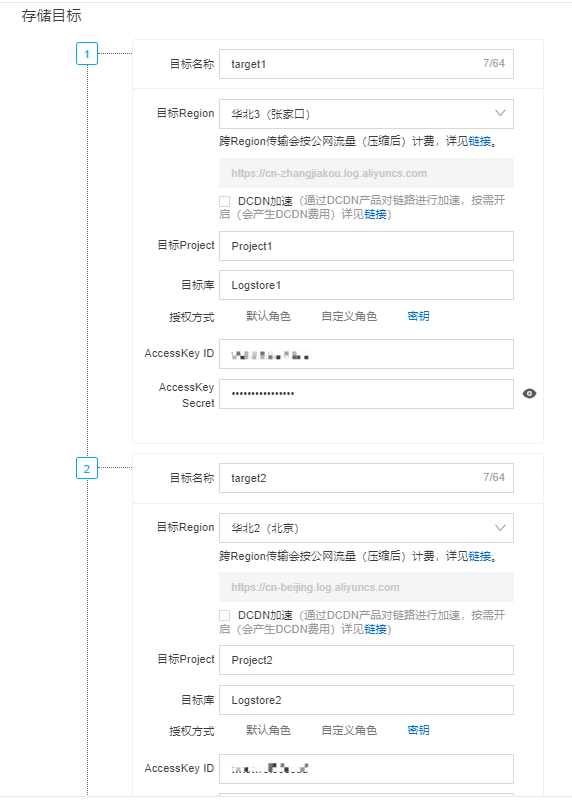
标号
存储目标
目标Project和Logstore
AccessKey
1
target0
Project0、Logstore0
不涉及
2
target1
任意选择,由e_output函数决定分发目标。
账号A的AccessKey信息
3
target2
任意选择,由e_output函数决定分发目标。
账号B的AccessKey信息
加工结果
## 分发到账号A的Project1下的Logstore1中。 host: example.aliyundoc.com project: Project1 logstore: Logstore1 http_status: 200 request_method: GET request_uri: /pic/icon.jpg scheme: https ## 分发到账号A的Project1下的Logstore2中。 host: demo.aliyundoc.com project: Project1 logstore: Logstore2 http_status: 301 request_method: POST request_uri: /data/data.php scheme: http ## 分发到账号B的Project2下的Logstore1中。 host: learn.aliyundoc.com project: Project2 logstore: Logstore1 http_status: 404 request_method: GET request_uri: /category/abc/product_id scheme: https ## 分发到账号B的Project2下的Logstore2中 host: guide.aliyundoc.com project: Project2 logstore: Logstore2 http_status: 504 request_method: GET request_uri: /data/index.html scheme: https
场景4:复杂场景动态分发
例如:某公司对一款游戏投放了广告,现在关于该游戏的所有API请求信息都存储在一个Logstore中。该公司希望通过解析useragent请求头,将来自不同设备(iOS、Android、Windows)的请求进行分发存储,并对method方法进行数据分析获取广告转化率。
针对上述需求,您可以通过日志服务数据加工和查询分析功能解决。
原始日志
__source__:127.0.0.0 __tag__:__receive_time__: 1589541467 ip:10.0.0.0 request_method: GET user_agent: Mozilla/5.0 (Macintosh; Intel Mac OS X 10.9; rv:50.0) Gecko/20100101 Firefox/50.0分发需求
将Windows用户请求信息分发存储到存储目标target1的Logstore1中。
将iOS用户请求信息分发存储到存储目标target2的Logstore2中。
将Android用户请求信息分发存储到存储目标target3的Logstore3中。
加工规则
本案例中,您可以使用ua_parse_os函数解析user_agent字段,使用dct_get函数获取请求头中的操作系统信息,再使用e_set函数新增一个字段os,值为操作系统信息,然后使用e_output函数和条件函数进行动态分发。
e_set("os", dct_get(ua_parse_os(v("user_agent")),"family")) e_if(e_search("os==Windows"),e_output(name="target1")) e_if(e_search("os=iOS"),e_output(name="target2")) e_if(e_search("os==Android"),e_output(name="target3"))存储目标
在创建数据加工任务页面中,配置存储目标。更多信息,请参见创建数据加工任务。
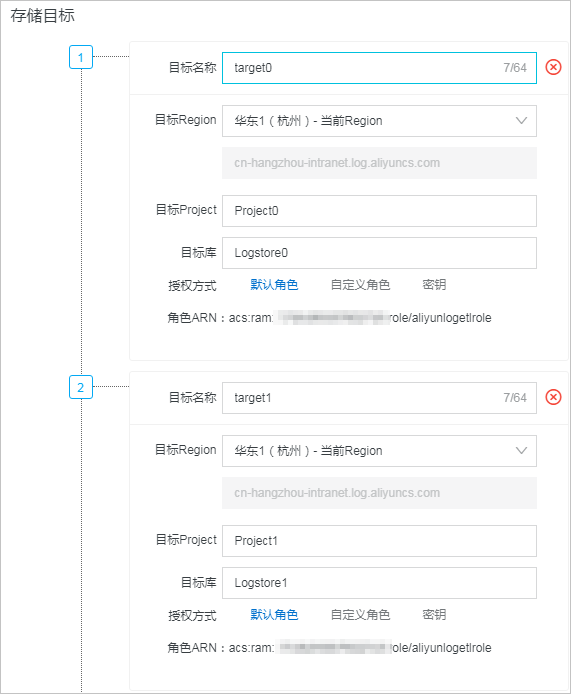
标号
存储目标
目标Project和Logstore
1
target0
Project0、Logstore0
2
target1
Project1、Logstore1
3
target2
Project2、Logstore2
4
target3
Project3、Logstore3
查询分析
在目标Logstore中进行查询分析操作,获取广告转化率,根据下述查询结果可知,Android用户的广告转化率较高。更多信息,请参见查询和分析日志。
在Logstore2的查询分析页面,输入如下查询分析语句,查看iOS用户的GET请求和POST请求占比。
* | SELECT Request_method, COUNT(*) as number GROUP BY Request_method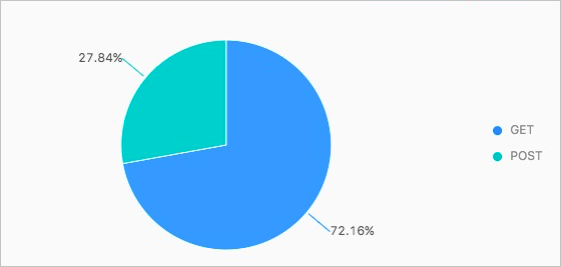
在Logstore3的查询分析页面,输入如下查询分析语句,查看Android用户的GET请求和POST请求占比。
* | SELECT Request_method, COUNT(*) as number GROUP BY Request_method